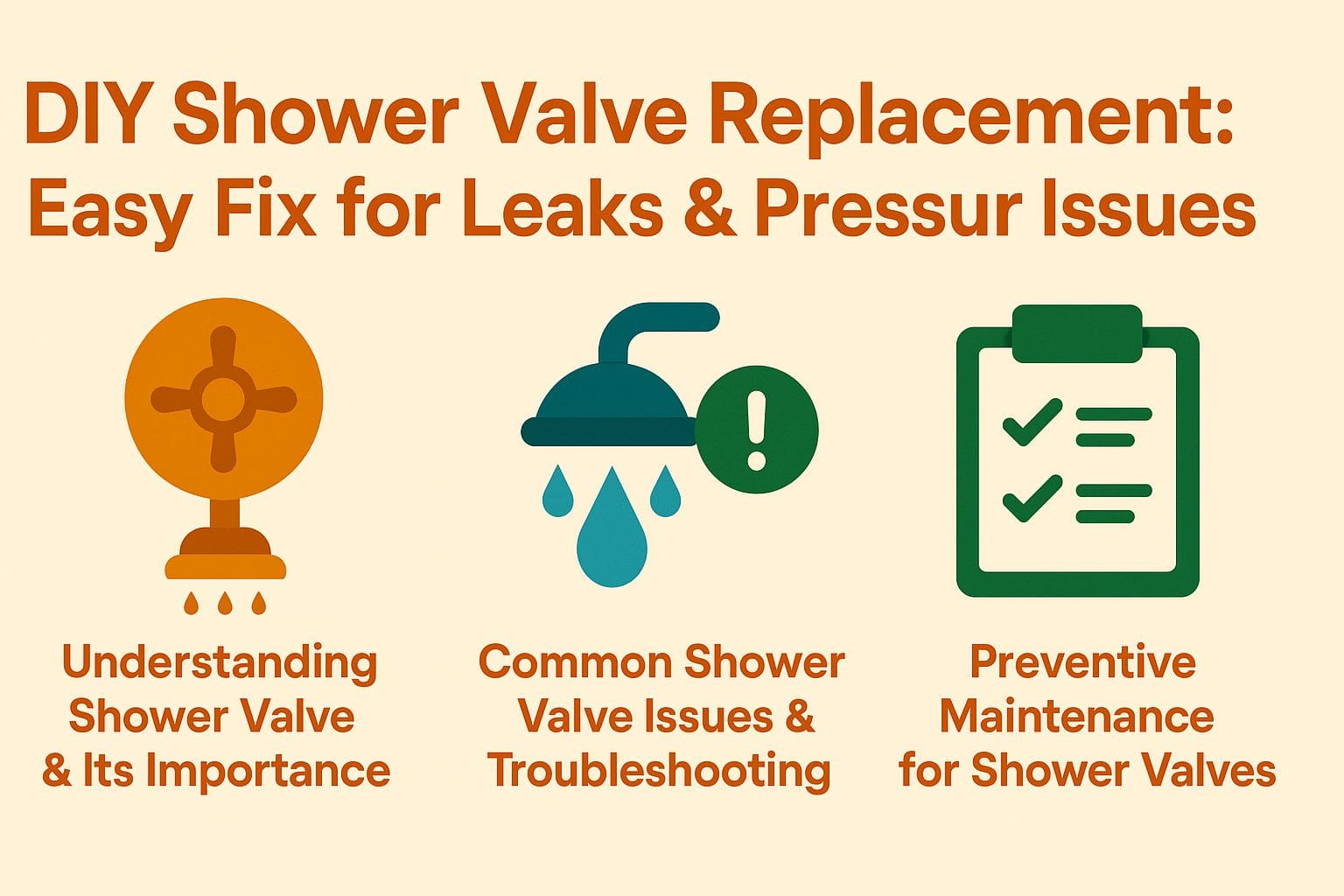
DIY Shower Valve Replacement: Easy Fix for Leaks and Pressure Issues
Is your shower acting up with leaks or inconsistent water pressure? You might be facing a common plumbing dilemma to hire a plumber, or to tackle on your own with the right DIY skills.
This troubleshooting guide will help you understand the signs of a faulty valve and provide step-by-step instructions for a seamless fix.
Say goodbye to those troublesome leaks and annoying drips and hello to a rejuvenated shower experience!
Learning About Shower Valves and Why They Matter in Home Renovation
Knowing about shower valves helps keep bathroom plumbing in good condition and makes sure water runs smoothly during showers. The shower valve controls the water supply and adjusts pressure to set the temperature, which is important for comfort and safety.
Knowing the differences between cartridge valves and compression valves can assist you with plumbing repairs and installations you handle yourself. Valves that function well prevent leaks and pressure issues, simplifying home upkeep and reducing the need for emergency repairs.

Common Shower Valve Issues and Troubleshooting
Common problems with shower valves can cause significant issues, such as leaks, changes in water pressure, pressure issues, and trouble with temperature control. Knowing about these problems is important for homeowners who want to fix things themselves or call a plumber.
A shower that leaks wastes water and raises utility costs, while a bad pressure balance can make your shower feel worse. Regular maintenance and checking can help you find and fix these common problems quickly, keeping your shower system dependable.
Identifying Leaks in Your Shower Valve through Proper Inspection
Identifying leaks in your shower valve can save you from costly repairs and excessive water wastage. Signs that your shower might be leaking include a steady drip, water pooling at the bottom, or variations in water pressure. By learning how to perform a leak detection inspection, you can quickly determine if the valve is the culprit or if other plumbing issues are at play. Knowing how valves work is important for fixing water leaks correctly.
To begin the inspection, turn off the water supply using the shut-off valve and check for visible signs of corrosion or damage around the valve area. A damp or discolored wall could also indicate a deeper issue requiring emergency repairs.
Next, you can use a simple method: place a bucket under the showerhead and watch for any dripping water. If there’s water collecting in the bucket, check the valve mechanism.
By following these simple steps, homeowners can perform effective leak detection and find leaks quickly. This makes it possible to try basic DIY water leak repairs and keep their plumbing system in good condition.
Types of Shower Valves
There are different kinds of shower valves, each with specific features and uses that can affect how you enjoy your shower and impact the valve assembly. Common types include:
- Cartridge valves
- Compression valves
- Pressure balance valves
Each type plays a distinct role in water control and temperature regulation within your shower system. Knowing these valve types is very important for picking the right one for your needs or doing a successful replacement for your DIY plumbing projects.
Cartridge valves use a replaceable component to control the flow, pressure regulation, and temperature, ensuring smooth function and long-lasting performance.
Compression valves work by turning knobs to press a washer, seals, and washers that manage the water flow. They are a classic and dependable option.
Meanwhile, pressure balance valves help maintain consistent water temperature by adjusting the flow rates of hot and cold water, ensuring a comfortable shower even if someone else in the household uses water simultaneously.
Choosing these parts from trusted plumbing suppliers will greatly improve your shower.
DIY Shower Valve Replacement Process and Installation Guide
Changing a shower valve might seem difficult, but with the right tools and a step-by-step guide, you can complete this DIY job and improve your bathroom’s plumbing. Begin by gathering essential plumbing tools such as a spanner wrench, plumber’s tape, and a repair kit designed for your specific valve type.
By following the installation steps one by one, the new valve will work well and stop leaks, leading to better water management, pressure adjustment, and stable pressure.
Before you begin replacing, make sure to turn off the water supply. This will create a dry and safe area for work.
You’ll then need to remove the handle and cover plate, which may require a screwdriver or Allen wrench. Carefully remove the old valve and remember its position for putting in the new one.
Once the new valve is in place, wrap plumber’s tape around the fittings to stop any leaks later. Once you have everything in place, check the system to make sure it is functioning. Pay attention to any hissing sounds or look for any leaks that might indicate a problem. If you find persistent issues, it could be one of the top signs you need to call a plumber for professional help.
Finishing this process will greatly improve how your shower works and keep your plumbing in good condition. Here is a cheat sheet:
🔧 Step-by-Step Shower Valve Replacement Chart
| Step | Action | Details |
|---|---|---|
| 1️⃣ | Turn Off Water Supply | Shut off water to the bathroom (main valve or localized shut-off). |
| 2️⃣ | Open Faucet to Drain Lines | Let any remaining water drain from the shower lines. |
| 3️⃣ | Remove Shower Handle & Trim Plate | Use a screwdriver to detach handle, escutcheon, and decorative trim. |
| 4️⃣ | Cut Open Wall (if needed) | Cut a section of drywall behind the valve (if rear access isn’t available). |
| 5️⃣ | Disconnect Old Shower Valve | Use a wrench or pipe cutter to disconnect water lines and remove valve. |
| 6️⃣ | Prepare Pipes for New Valve | Clean copper pipes or attach adapters for PEX/CPVC if needed. |
| 7️⃣ | Install New Shower Valve | Position new valve per manufacturer specs; solder or connect pipes. |
| 8️⃣ | Test for Leaks | Slowly turn on water and inspect for leaks before closing the wall. |
| 9️⃣ | Reattach Trim & Handle | Screw on the escutcheon plate and handle once valve is secure. |
| 🔟 | Patch Wall (if applicable) | Repair drywall or close access panel behind shower. |
Preventive Maintenance for Shower Valves
Taking care of your shower valve often helps it last longer and prevents costly plumbing repairs later. By regularly inspecting the valve for wear and monitoring water quality, you can find plumbing issues early (see also: The Top 10 Signs You Need to Call a Plumber).
Simple DIY tasks, such as cleaning the valve parts and replacing washers, can keep your shower in good condition and support your home maintenance efforts with proper plumbing maintenance.
About the Author:
Mark Ellington is a home improvement expert and CEO of a $50M remodeling firm. With 20+ years of experience and a degree in Construction Management from Purdue, he shares practical renovation tips, pricing insights, and contractor advice at 5Estimates.com to help homeowners make smart, informed decisions on their projects.

Leave a Reply